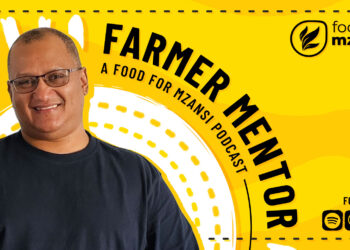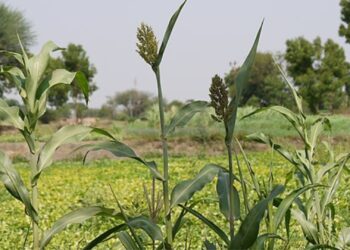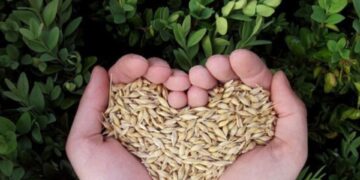
“Permaculture principles are thinking tools that enable the farmer to creatively design a food production system that is robust, resilient, self-sustaining and ecologically sustainable,” says Delwyn Pillay, full-time volunteer and activist for Greenpeace Africa, and an ecologist at heart.
Over the last few years there has been a greater public awareness of the harmful impacts of industrial agriculture. As a result, there’s been a steadily growing movement and support of more sustainable farming systems such as permaculture and other traditional farming practices.
“Permaculture and traditional farming practices are based on indigenous or traditional knowledge that has been developed over many generations to form farming systems that are regenerative, self-sustaining and resilient systems modelled from natural ecosystems,” says Pillay.

“Sadly, these self-sustaining farming practices were discouraged and replaced in favour of industrialised farming to supply the global food market. We have seen severe environmental problems such as ecosystem collapse and health consequences as a result of this transition to more concentrated and mechanised agriculture.”
ALSO READ: Vertical farming: 6 tips on how to start up
What is permaculture?
“Permaculture is fun with tasty rewards,” says Pillay.
There are many definitions of permaculture, some very wide and others very specific. Bill Mollison, the first person who coined the term permaculture in 1978, defined it as follows:
“The conscious design and maintenance of agriculturally productive systems that have the diversity, stability, and resilience of natural ecosystems. It is the harmonious integration of the landscape with people providing their food, energy, shelter and other material and non-material needs in a sustainable way.”
But what does this mean? What does this look like in practice?
Andrew Ardington, founder of the Regenerative Agriculture Association of South Africa, sees permaculture as falling under the broader concept of regenerative agriculture.

“At the core it looks at two things, first the care of the soil,” says Ardington. “And secondly working with, rather than against nature.”
Ardington also adds that permaculture has the lifestyle of the farmer at its core. This means a farm that offers more than just food and an income, but a lifestyle of learning and a space to connect with nature.
“Permaculture offers us a way to learn from nature, and from other people, observing how others have moved to a greener and more ethical approach, and working with the world around us to succeed in our goals,” Pillay believes.
ALSO READ: Eco-warriors grow food at public pool
Pillay, who started a permaculture-based community garden in Durban, prefers the idea of permaculture and more traditional farming practices over industrialised methods of farming that are based on monocropping and intensive use of resources such as water, fertiliser, pesticides and herbicides.
Steps to implementing permaculture principles:
According to Pillay there are twelve permaculture design principles to follow:

1. Observe and interact
“Take time to observe the land,” says Pillay. “Know where the wind blows from, which parts get more sunlight, and so forth.”
Observing and interacting with the land will determine your design layout to best optimise the natural elements. Interact; dig up some soil to see what the soil is like; get to know the organisms that are in the soil.
“Farmers are part of the system,” says Ardington. “Rather than distant observers pulling levers from afar.”
2. Catch and store energy
You will need to put a system in place that will collect resources when they are abundant and save them for when resources are low. Pillay gives the example of installing solar panels to capture the sun’s energy on sunny days , which can be stored in batteries to be used as a power source on overcast days.
“As the saying goes, ‘make hay while the sun shines’!”
3. Obtain a yield
Your efforts should pay off and provide something that you need, whether it is food, water or energy.
Obtaining a yield can be as simple as using permaculture techniques to provide food and income, but it can also be about obtaining a non-tangible yield: happiness, health and mental well-being.
“Don’t waste your personal energy and resources on something that ultimately is not going to provide value,” says Pillay. “Design systems around you so that you can best leverage your activity.”
4. Apply self-regulation and feedback
“Always check your energy state,” Pillay says. “You don’t want to overwork and reach a point of burnout. Make sure that growing food is fun and enjoyable, too!”
Constantly observe your farming and your own moods, find patterns and see where you should make changes to see better outcomes.
5. Use and value renewable resources and services

Nature provides natural resources for our needs, like fresh water. But destroying natural ecosystems, for example polluting a stream, will result in the loss of fresh usable water, not just for oneself but for other water users as well.
“So, use the resources that nature gives you, appreciate them, and do not abuse the natural systems that provide those resources,” says Pillay.
6. Produce no waste
“In nature there is no such thing as waste,” says Pillay. “Waste is a human phenomenon that pollutes the environment with harmful toxins.”
By valuing and making use of all the resources that are available to us, nothing goes to waste.
“For example, food scraps can be turned into compost.”
7. Design from patterns to details
Harness and leverage the observed patterns of the sun, wind, rain and topology of your environment rather than work against them. These will form the backbone of your farming system designs.
“Start with the big picture and work inwards from there,” says Ardington. “We need to think holistically.”
8. Integrate rather than segregate
Plants thrive when they are planted in polycultures, meaning a diverse set of plants working together. As well as applying this to your farm, you can also apply it to communities, groups or organisations.
“A permaculture system is part of the larger ecosystem,” says Pillay. “To develop a healthy, functioning ecosystem we need each other for collaborative effort and to support each other to enable good, clean and fair food producing systems.”

9. Use small and slow solutions
“Start small and grow, learning as you go,” says Ardington.
Small and slow systems are easier to maintain than big ones, according to Pillay. Make better use of local resources and build slowly on your knowledge networks to produce more sustainable outcomes.
10. Use and value diversity
Biodiversity is one characteristic that is basic to any sustainable system. Diversity represents resilience. As with integration, this philosophy can be applied to your farm as well as to your community.
“Nature does not work in monocultures,” Ardington emphasises. “And we need to be aware that monocultures do not do a good job of feeding our soil biology.”
11. Use edges and value the marginal
According to Pillay the place where two ecosystems or habitats meet is generally more productive and richer in the variety of species present than either habitat on its own.
“For example, look at the edge of a dam and grassland,” says Pillay. “This will be an optimal area for growing crops.”
Make use of all the resources made available to you. Find ways to utilise surfaces and areas that might look like they are just a waste of space. A fence doesn’t have to be just a fence, it can be a whole vertical veggie garden!
12. Creatively use and respond to change
Nature is never static, so a food production system must be designed to be adaptable to change.
One can have a positive impact on inevitable change by carefully observing and then intervening at the right time, according to Pillay.
As you can see, these principles of agriculture apply just as well to ways of life as it does to farming, Ardington points out.
Want to get started in permaculture?
Pillay mentions that there are local permaculture network groups that can be found on the internet and on various social media platforms such as the PERMACULTURE Southern Africa Facebook group which offers support and a space to share information.
The Permaculture South Africa website is another platform providing permaculture-based training, and volunteering opportunities on a permaculture farm.

















